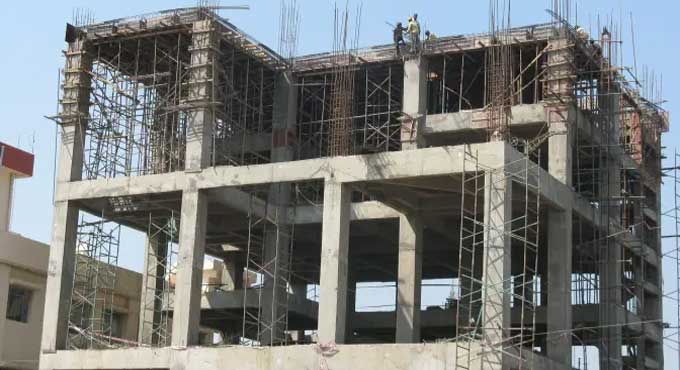
Types of Shuttering in Construction

Shuttering, also called formwork, is a temporary support used to mold concrete into the desired shape, in which the concrete gains initial strength, hardens, and matures. As we produce PCC, RCC construction elements in the form of shuttering for buildings, bridges, tunnels, hydroelectric dams, sanitary pipelines, and more, shuttering comes in different shapes and sizes.
Materials for Shuttering
Steel Shuttering
It is more expensive to use steel in shuttering in the beginning, but on the whole, this proves to be more economical than timber shuttering, as steel can be reused more than ten times.
Since steel shuttering gives excellent exposed concrete surfaces, there is less need for further finishing. Since steel cannot absorb water, the chances of developing honeycombs are negligible. It is more durable and possesses greater strength than other models.
Plywood Shuttering
Shuttering made from plywood is gaining popularity since it presents a smooth surface that doesn't require any finishing treatments and can also reuse 20 to 25 times. A large amount of plywood can be used to cover up the shuttering, so the labor cost of removing and fixing it is greatly reduced.
Timber Shuttering
Smaller works requiring fewer repetitions are typically produced this way because of their low initial cost. A well-seasoned piece of wood should be free of loose knots, light in weight, easily workable with nails, and free from splitting. It is possible to reuse these shutters up to 12 times.
Requirements of Shuttering in Construction
Following are the qualities of a good shuttering:
A. Shuttering should be made from a cheap material that can be reused several times.
B. In order to prevent concrete water absorption and leaks, the form should be practically waterproof. Additionally, it shouldn't shrink or swell too much.
C. Concrete and live loads such as pouring, vibration, compaction, and curing should easily be carried by it.
D. So that it exhibits the least amount of deflection, the rigidity and stiffness should be sufficient.
E. Lightweight, smooth, and easily stoppable should be its first requirements.
F. A shuttering should have leak proof joints at all times.
G. Supports should not be moved while the shuttering is in place.
Shuttering Loads
On shuttering, in addition to its load, the following loads occur:
A. Live load caused by labor, etc.
B. Wet concrete has a deadweight of about 250 pounds.
C. In fluid concrete, the hydrostatic pressure acts on a vertical face or an inclined surface.
D. Concrete pouring has an impact.
E. Working with vibrators produces vibration loads.
F. The stress of moving equipment during erection.
Concrete Column Shuttering
When compared to other complex structural elements, shutters for a column are simple.
The main components of column shuttering are:
A. Periphery of columns are covered in mesh,
B. The yokes on the sides and at the ends,
C. A wedge,
D. Washers with bolts.
Beam & Slab Floor Shuttering
Most beams are parallel to 2.5 cm thick sheathing laid on top of the slab. Battens used to hold the sheathing, which inserts between beams at an appropriate distance. Through the joists of the span, the battens can also be propped to mitigate deflection. Three-cm-thick sheathing is used in the side forms of the beam. There could be 5 to 7 cm of bottom sheathing on the beam form.
Walls Shuttering
An appropriate thickness of boarding uses, a horizontal board is mounted on posts measuring 5 cm by 10 cm, called studs or soldiers. The posts have spaced a distance of about 0.8 m apart. A series of horizontal whaling, each measuring 7.5 cm by 10 cm, is fixed at appropriate intervals to the posts.
It is maintained by providing a concrete kicker at the bottom of the shutters and nailing 2.5 cm by 5 cm spacers to the posts, so the shutters keep as far apart as the wall thickness.
There is generally no boarding only, 15 mm plywood used. As a result, when wall panels are installed, the lower ones are often removed when the wall is constructed using concrete.
The 5 cm x 10 cm frames use For the Ply shutter. Two studs should be located at the ends of each panel to fix them centrally. A stud consists of two five cm-square timbers spaced 15 cm apart and blocked together.
Its foundation wall is showing cracks at either end of a section that is experiencing downward movement caused by soil bearing failure. There is a problem with the concrete beneath your home.
Concrete Stairs Shuttering
Three planks measure four to five centimeters thick and equal the riser's height. Planks of this type are beveled at the bottom to allow trowel ling of the whole tread surface. Following the installation of the reinforcement, riser planks are positioned. Leaving the treads open allows concrete to place and vibration to occur.
Conclusion
Shuttering accounts for between 20 and 25% of the cost of the structure for building work but may reach much higher levels in bridge construction. Shuttering and its construction must be mechanized to reduce the shuttering cost. After the concrete is sufficiently solid, the shuttering will have to be removed. It also calls stripping to remove the shuttering. The components are removed during the stripping process and can be used in further construction processes or other projects. Shuttering components that can repeat are known as panel forms.


